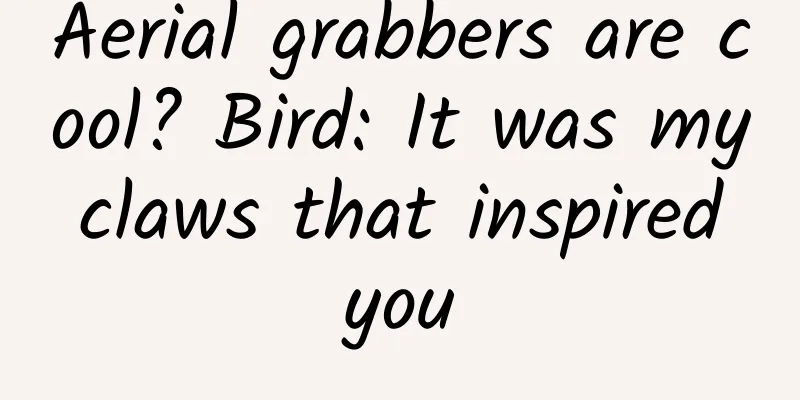Aerial grabbers are cool? Bird: It was my claws that inspired you

|
If you like to visit parks, you must have seen birds happily jumping on branches. Have you ever noticed that it seems that no matter whether the branches are thick or thin, smooth or rough, or even covered with moss, birds can always treat them equally, clinging to the branches like roots, and even squatting on them to take a nap is a piece of cake. Birds standing firmly on the branches (Photo source: Sina Weibo https://weibo.com/1867169435/FAMXKznUl) Careful scientists discovered this phenomenon a long time ago and learned from birds. Finally, they succeeded in equipping the "little bird" in the field of science and technology - the drone - with a pair of claws and named this mechanical claw SNAG. GIF: SNAG can hold onto objects tightly and land like a bird (Image source: https://www.science.org/doi/10.1126/scirobotics.abj7562) Two scientists, Mark Cutkosky, an engineer at Stanford University in the United States, and David Lentink from the University of Groningen in the Netherlands, were inspired by birds and invented the robotic claw SNAG that can be mounted on a drone, which appeared on the cover of the famous scientific journal Science Robotics. At present, this mechanical claw has been successfully mounted on the drone they manufactured, and has been subjected to experiments and actual mission tests in multiple dimensions. Why are birds able to master this skill? How can scientists learn from birds and add such a reliable pair of claws to drones? Part 1 A pair of claws with amazing structure and exquisite bones There are many different types of birds, and their ability to hold onto branches varies. Birds such as ostriches, flamingos, and ducks do not have the ability to fly long distances or perch on trees, so their claws have relatively weak gripping abilities. However, most other birds can easily stand firmly on branches and even sleep on them. In fact, the biggest contributor to this ability of birds is the special structure of their claws. From the epidermis to the muscles, to the ligaments and then to the bones, millions of years of evolution have made every detail of the bird's claws tailor-made for the small action of "grasping". The falcon's strong and powerful claws (Photo credit: Veer Gallery) Let's start with the skin. I believe everyone has eaten a dish called "tiger skin chicken feet". If we look closely, we will find that the surface of chicken feet is full of small bumps, and the bumps are more dense in the part that contacts the ground. The claws of most other birds also have this scaly keratinous hard skin structure, which can maximize the contact area and friction between the bird's claws and the ground, allowing the bird to hold firmly even on the smooth wire. In addition, this layer of skin is hard and has no pain nerves, ensuring that when the bird sees a branch or rough ground, it can land and stop without thinking, without worrying about being cut or scratched. The epidermis of bird claws has a scaly, keratinous, hard skin structure (Image source: Veer Gallery) Not only is the skin of the claws exquisite, the muscles, ligaments, and bones of birds are more like a fine machine that fits perfectly. Most birds have three claws in front and one in the back. These claws are thin and long, suitable for wrapping around branches of different thicknesses. When the bird's claws grab the branch, the bird will quickly squat down and bend its legs. The flexor tendons will automatically tighten, driving the claws to clasp the branch. The tiny action of "sitting down" seems to drive a series of mechanisms, all in one go. At this time, the clasped claws are like "locked", and they will not be easily loosened even if you take a nap. Part 2 It needs to sleep and hunt, this is a pair of very busy paws Do you think that a bird's "locked" claws must be full of strength? Surprisingly, unlike human hands, which tense their muscles when grasping objects, the muscles of birds are relaxed when their claws are clenched. That is, birds only need to exert force when they fall and take off, but they have no difficulty landing on branches and holding on to tree trunks. Because of this, birds can easily rest and take a nap on tree branches. In addition, birds usually have a light sleep level, and they can even sleep with half of their brains asleep while the other half stays awake. Therefore, when taking a nap on a tree, birds can still adjust various parts of their bodies and maintain balance. Such delicate, flexible, strong and powerful claws are also the weapons of many birds for hunting. The main weapons of carnivorous birds are beaks and claws, and eagles are the best at using these two weapons to the extreme. The gripping force of eagle claws exceeds that of humans by ten times, and can easily pierce the skulls of large animals. It is a real weapon. Because bird claws are so precise and practical, scientists have gained a lot of inspiration from them when creating inventions. Part 3 SNAG: Another example of humans learning from birds In the early days, humans learned the principles of bird flight, improved and invented airplanes. Although the structure of helicopters and small drones with propeller wings is no longer similar to that of birds, people can still get a lot of inspiration from birds and then install them on drones. Today's mechanical claw SNAG is another result of humans learning from birds. A drone equipped with SNAG is firmly attached to a tree (Image source: Reference [1]) SNAG is made of 3D printing technology, which is lightweight, strong and durable. The overall structure is modeled after the eagle claw, including the claw skin, bones and key linkage tendons. The surface of the SNAG has toe pads and claw tips that increase friction, ensuring sufficient friction with the contact surface. The transmission structure composed of gears and connecting rods, similar to the skeletal tendons of eagle claws, ensures the firmness and low energy consumption of the grip. Similar to the characteristics of bird muscles, when maintaining a static grip, the SNAG is also in a natural low-energy state. This eagle claw-like design was a great success, and SNAG was able to hold on to different surfaces for a long time, including branches and uneven ground that were large enough to support the weight of the drone. It could also grasp and pick up objects according to instructions, just like a real eagle claw. Part 4 What can we do with SNAG? Like an excellent bird claw, the main tasks of this mechanical claw are docking and grasping, and these two functions are of extraordinary significance to the actual operation of the drone. First of all, docking is an important measure to save power for drones. Friends who have played with drones should have a deep understanding that endurance is one of the key indicators to test the performance of drones. However, in tasks such as wildlife monitoring and situation surveys, drones are required to hover for a long time, so that the existing power supply cannot support the completion of the task. If SNAG can be used for docking, the power consumption will be less than 1/10 of that of hovering, which greatly alleviates the problem of insufficient endurance of drones. Secondly, the ability to grab and transport objects is of great significance to the versatility of drones. In certain environments, such as complex and rugged areas that are difficult for humans to reach or areas with high accident risks, such as mines filled with toxic gases and swamps where dangerous creatures lurk, drones can complete the tasks of rapid detection, sampling and short-distance transportation. GIF: SNAG is able to take off and land smoothly (Image source: https://www.science.org/doi/10.1126/scirobotics.abj7562) Although SNAG still has some problems, such as the grasping operation requires human control and cannot automatically detect suitable surfaces or branches for grasping, it still gives us a broad space for imagination. In the future, SNAG may become a standard feature of drones in certain complex scenarios, enabling long-term operation and flexible sample collection of drones. It may also shine in application scenarios such as other types of robots and even Mars rovers. SNAG is another wonderful achievement of human beings imitating birds, and it is another progress of bionic robots. In fact, the essence of science is to make progress in such continuous exploration, inspiration, and innovation, learn from nature, master the laws, and turn them into the power of human progress. Pay attention to the people around you, focus on thinking about migration, maybe the next popular discovery is hidden in the grove downstairs from your house. References: [1] Roderick, WRT, et al. (2021). "Bird-inspired dynamic grasping and perching in arborealenvironments." Science Robotics 6(61): eabj7562.. Produced by: Science Popularization China Author: Zhiyao Science Popularization Producer: Computer Network Information Center, Chinese Academy of Sciences The article only represents the author's views and does not represent the position of China Science Expo This article was first published in China Science Expo (kepubolan) Please indicate the source of the public account when reprinting Please indicate the source of the reprint. Reprinting without authorization is prohibited. For reprint authorization, cooperation, and submission matters, please contact [email protected] |
<<: How were China's peculiar table-shaped mountains formed?
Recommend
How can advertisers use Xiaohongshu KOL to promote Xiaohongshu?
Xiaohongshu is known as the "overseas shoppi...
Event promotion and operation: 8 hot creative forms of H5!
It cannot be denied that, on the basis of guarant...
Tesla: Tesla delivered 254,700 vehicles in Q2 2022, higher than 201,250 vehicles in the same period of 2021
Tesla recently introduced that in the second quar...
What are the equipment for real-name authentication at construction sites?
With the introduction of various national policie...
Tik Tok and Kuaishou authentication methods and steps!
Before entering today's course, let me share ...
How KOLs earn millions by selling courses (Part 2)
How KOLs earn millions by selling courses (Part 1...
What would happen to our lives if the Earth changed its size?
Is the size of the Earth fixed? Can we change its...
What are the business models of free Internet products and what are the profit points?
When I was in adolescence, I learned about some i...
Is it safe to eat the Basa fish that costs only a few dollars a pack in the supermarket?
Have you noticed that restaurants love to use Bas...
How to operate CPD delivery? There are these processes!
We have learned about the delivery of CPD before,...
[Kinetic Taping Technology] Kinesiology Taping Video
[Kinetic Taping Technology] Introduction to Kines...
【Lin Zouxin】Zouxin Academy Portrait Photography Post-production
【Lin Zouxin】Zouxin Academy Portrait Photography P...
Scientific Imagination: How can humans achieve level one civilization, and what will it look like then?
There are many theories or conjectures about cosm...
Tips for operating a TikTok account with huge traffic!
Today I want to talk to you about the quality of ...
This "breath-holding suffocation game" is popular in schools. Tell your children not to participate
Recently, parents of students in many places have...









